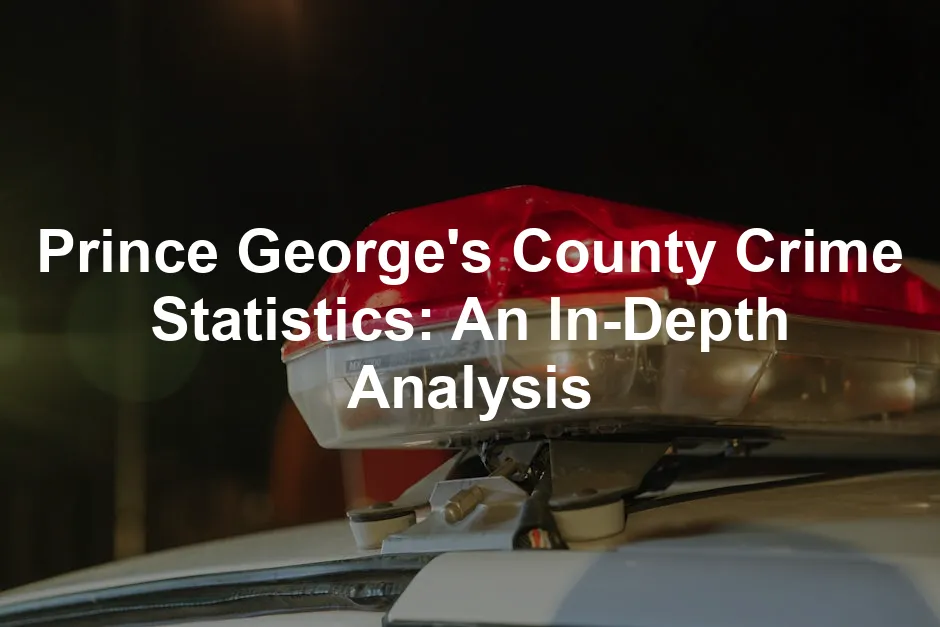Introduction
Prince George’s County, nestled in Maryland, serves as a vibrant community with a diverse demographic profile. This area boasts a rich tapestry of cultures, traditions, and histories, making it a unique place to live, work, and play. Yet, like many urban locales, it faces its share of challenges, particularly concerning crime. Understanding crime statistics in Prince George’s County is crucial for fostering a sense of safety and security among its residents.
Why should crime statistics matter to you? For residents, it provides valuable insights into safety levels and potential risks in their neighborhoods. Policymakers rely on these statistics to allocate resources effectively and implement strategies that enhance community safety. Newcomers contemplating a move to the area can utilize this information to make informed decisions.
Despite some positive trends indicating a decrease in overall crime rates, alarming spikes in certain categories, especially violent crime, remain a significant concern. The nuances of these statistics reveal a complex picture that underscores the importance of vigilance and community engagement.

Understanding Crime Statistics
Crime statistics represent a collection of data that quantifies criminal activity within a specific area over a given period. These statistics are vital for gauging the safety of a community and identifying patterns that may inform law enforcement strategies. When analyzed properly, they can provide insights into the effectiveness of various crime prevention initiatives.
The sources of crime statistics are diverse. Local law enforcement agencies, such as the Prince George’s County Police Department, are primary contributors. They compile data on reported crimes and arrests. Additionally, the FBI collects and publishes national crime data through its Uniform Crime Reporting (UCR) Program. This information is invaluable for understanding broader trends and making comparisons across different regions.
Speaking of understanding broader trends, there’s no better way to dive into the sociology of crime than with a good read. Check out “The New Jim Crow: Mass Incarceration in the Age of Colorblindness” by Michelle Alexander. It provides a critical look at systemic issues within the criminal justice system.
Crime statistics are typically categorized into two main types: violent crimes and property crimes. Each category serves distinct purposes in understanding community safety. Violent crimes encompass offenses that involve force or threat of force, including murder, rape, robbery, and assault. In contrast, property crimes involve the theft of or damage to property, such as burglary, larceny, and motor vehicle theft.
The significance of context in interpreting crime statistics cannot be overstated. For instance, a rise in violent crime in a specific neighborhood might correlate with socioeconomic factors, such as poverty or unemployment. Recognizing these connections can lead to more effective solutions tailored to the community’s needs.
In summary, understanding crime statistics is essential for residents, policymakers, and community leaders. These numbers not only reflect the current state of safety but also serve as a foundation for strategic planning aimed at reducing crime and enhancing the quality of life in Prince George’s County.

Types of Crimes
When it comes to crime statistics, it’s essential to understand the two main types: violent crimes and property crimes.
Violent crimes involve acts that inflict physical harm or the threat of harm on individuals. These include serious offenses like murder, rape, robbery, and assault. Picture someone yanking your purse away while you’re just enjoying a sunny day. It’s alarming, right? That’s a violent crime.
On the other hand, property crimes focus on the theft or destruction of someone else’s property. This includes burglary, larceny, and motor vehicle theft. Think about it—if someone breaks into your garage and makes off with your beloved bike, that’s a property crime.
While both types of crime can be distressing, they impact communities differently. Violent crimes create an atmosphere of fear, while property crimes often lead to financial loss and a sense of vulnerability. To help secure your belongings, consider investing in a reliable Home Security System with Camera. It can provide peace of mind and protect your home from unwanted intruders.

Importance of Context
Now, interpreting crime statistics requires a pinch of context. Numbers alone can be misleading. For instance, a spike in violent crime in one area may not mean the whole county is unsafe. It could be linked to specific issues—like rising domestic violence or drug-related incidents.
Communities are complex. Socioeconomic factors, such as poverty and unemployment, can influence crime rates. If a neighborhood struggles with these issues, crime rates may reflect that reality. However, programs addressing these root causes can lead to safer streets.
Understanding the context around crime statistics helps residents and policymakers devise effective strategies. It’s not just about what the numbers say but why they are what they are.
In conclusion, grasping the distinction between violent and property crimes is fundamental. Coupled with contextual understanding, it enables communities to develop informed responses to crime, fostering a safer environment for everyone.

Property Crimes in Detail
Statistical Breakdown
Property crimes in Prince George’s County have been a significant concern. The latest statistics reveal a property crime rate of 41.2, surpassing the national average of 35.4. Let’s break it down:
- Burglary: This involves breaking into homes or businesses with intent to commit theft. Recent data shows a steady number of burglaries, indicating persistent vulnerabilities in residential security.
- Larceny: This refers to the theft of personal property without breaking and entering. Larceny rates have been notably high, often linked to opportunistic thefts in crowded places. Whether it’s your favorite jacket or that shiny new smartphone, larceny can happen anywhere.
- Auto Theft: This crime has seen alarming spikes, particularly with nearly 100 carjackings reported this year. Juveniles are often involved, raising concerns about community safety and youth engagement.
Want to protect your vehicle? Consider a Car Dash Cam. It can help provide evidence in case of an incident, ensuring you’re covered.

Current Trends
When comparing these property crime rates to previous years, a mixed picture emerges. While overall crime has decreased by 10% compared to last year, property crime rates tell a different story. The county has recorded an uptick in auto thefts and larcenies, which counters the positive trend in nonviolent crime.
Experts suggest that the rise in auto thefts correlates with economic factors and the prevalence of organized crime. As Chief Malik Aziz pointed out, thefts from vehicles have increased, suggesting that criminals are taking advantage of lax security.
In conclusion, while some property crime statistics are improving, challenges remain. Residents should stay vigilant, implement security measures, and engage with community programs to help combat these issues. One great way to enhance your security is by using a Smart Door Lock that allows you to control access remotely!

Crime Comparisons with Nearby Areas
Crime in Nearby Cities
When examining crime rates, it’s essential to compare Prince George’s County with its neighboring cities. This gives us a clearer picture of the crime landscape in the region. Here’s a snapshot of crime rates in nearby cities:
| City | Violent Crime Rate (per 100k) | Property Crime Rate (per 100k) | Population | Data Year |
|---|---|---|---|---|
| Seat Pleasant, MD | 749.5 | 2,165.3 | 5,074 | 2019 |
| Fairmount Heights, MD | 652.3 | 2,739.7 | 1,555 | 2019 |
| Cheverly, MD | 370.3 | 1,913.0 | 6,630 | 2019 |
| Glenarden, MD | 64.2 | 866.2 | 6,511 | 2019 |
| Landover Hills, MD | 543.5 | 4,649.8 | 1,821 | 2019 |
| Capitol Heights, MD | 417.5 | 1,318.4 | 4,188 | 2019 |
Key takeaways from this table reveal that cities like Seat Pleasant and Fairmount Heights have notably high violent crime rates compared to Prince George’s County. Seat Pleasant’s violent crime rate of 749.5 per 100,000 is strikingly higher than the county’s rate. This disparity suggests that while Prince George’s County faces challenges, some neighboring cities experience more severe crime issues.
Interestingly, property crime rates tell a different story. Fairmount Heights leads with a property crime rate of 2,739.7 per 100,000, indicating that the theft and burglary issues might be more prevalent there. This information can help residents understand how their safety compares to nearby areas and what areas might require more attention and resources.

Comparing crime statistics can provide valuable insights into community safety. For a detailed analysis of crime statistics, check out this fremont crime statistics article.
Crime in Similar Size Cities
Let’s broaden our lens and compare Prince George’s County to other cities of similar size, like Virginia Beach and Newark.
| City | Violent Crime Rate (per 100k) | Property Crime Rate (per 100k) | Population | Data Year |
|---|---|---|---|---|
| Virginia Beach, VA | 129.4 | 1,760.7 | 442,784 | 2019 |
| Newark, NJ | 619.0 | 1,641.0 | 278,906 | 2019 |
| Jersey City, NJ | 522.7 | 1,903.9 | 233,242 | 2019 |
| Pittsburgh, PA | 578.8 | 3,016.1 | 308,609 | 2018 |
| Durham, NC | 730.0 | 3,807.6 | 280,282 | 2019 |
| Raleigh, NC | 255.7 | 1,783.1 | 406,005 | 2019 |
In this comparison, Prince George’s County’s violent crime rate stands out, sitting slightly above the national average. For instance, Newark’s rate of 619 per 100,000 is significantly higher than Virginia Beach, which boasts a commendably low rate of 129.4.
Factors influencing these crime rates often include economic conditions, community resources, and policing strategies. Virginia Beach, for example, benefits from a strong tourism industry, which can enhance community engagement and funding for public safety initiatives. Conversely, areas like Newark face more significant socio-economic challenges that can contribute to higher crime rates.
Understanding these contextual factors is crucial. They enable residents and policymakers to identify potential solutions tailored to their specific community needs and challenges. As we analyze crime across different regions, it becomes evident that tackling the root causes of crime—such as poverty, lack of education, and community disinvestment—can lead to safer neighborhoods for everyone.
In conclusion, comparing crime statistics between Prince George’s County, nearby cities, and similar-sized urban areas provides valuable insights. It reveals not only the challenges faced but also potential pathways for improvement and community safety initiatives.

Economic Implications
Cost of Crime High crime rates in Prince George’s County can negatively impact the local economy. When crime is rampant, property values often take a hit. Homeowners may find their investments dwindling as potential buyers steer clear of neighborhoods with high crime. It’s like trying to sell a beach house in the middle of a snowstorm—no one wants to take that plunge!
Insurance costs can also skyrocket. Residents may face higher premiums due to the increased risk of theft or vandalism. This can strain household budgets and push families to reconsider their living arrangements. A safer community means happy homeowners and a thriving real estate market.
Community Initiatives Fortunately, community efforts can help mitigate these economic effects. Local organizations and initiatives bring people together, fostering a sense of safety and cooperation. Programs like Jacob’s Ladder work with youth to address underlying issues, reducing crime and improving community relations.
When residents feel invested in their neighborhoods, they are more likely to report suspicious activities and collaborate with law enforcement. This proactive approach can lead to lower crime rates, boosting property values and attracting new businesses. Ultimately, a united community can turn the tide, making Prince George’s County a safer and more vibrant place to live.

Conclusion
Summary of Findings In summary, crime statistics in Prince George’s County reveal a mixed bag of trends. While overall crime has decreased by 13%, violent crime has increased by 11%. Property crimes, like burglary and auto theft, remain concerning. The county’s violent crime rate is higher than the national average, which raises alarms for residents and officials alike.
Moreover, the economic implications of crime are significant. High crime rates can lead to decreased property values and increased insurance costs. However, community initiatives play a crucial role in combating these issues. Organizations working together can foster a sense of safety and collaboration, ultimately leading to a healthier community.
Call to Action Now is the time for residents to get involved! Staying informed about local crime trends is essential. Participate in community safety initiatives and join local groups focused on crime prevention. Your involvement can make a difference and help create a safer environment for everyone.
Don’t forget that personal safety is also key. Consider adding a Personal Safety Alarm to your everyday carry, just in case you ever feel uneasy.
Final Thoughts Continued vigilance and cooperation are vital in addressing crime in Prince George’s County. By working together, residents can help create a safer community where everyone can thrive. Remember, safety is a shared responsibility, and every little effort counts towards building a brighter future.

FAQs
What is the overall crime rate in Prince George’s County?
The most recent data shows that Prince George’s County has a violent crime rate of 24, slightly above the national average of 22.7. Property crime rates are also concerning, sitting at 41.2 compared to the national average of 35.4. Overall, the county has experienced a 10% decrease in crime compared to last year, but violent crime has risen by 4%.
How does Prince George’s County compare to other areas in Maryland?
When compared to other areas in Maryland, Prince George’s County has higher crime rates than the state averages. For instance, while the state average for violent crimes is lower, Prince George’s County’s rates are higher, making it essential for residents to stay informed and engaged.
What are the most common types of crime in Prince George’s County?
The most prevalent crime categories in Prince George’s County include violent crimes like assault, robbery, and domestic violence. Property crimes such as burglary, larceny, and auto theft are also significant concerns, with alarming trends in recent years.
What should residents do to stay safe?
Residents should stay vigilant and implement safety measures like installing home security systems. Participating in neighborhood watch programs and staying connected with local police can also enhance community safety. Furthermore, always report suspicious activities to law enforcement.
How can I get involved in community safety initiatives?
Getting involved is easier than you think! Attend local community meetings, volunteer with organizations like Jacob’s Ladder, or join neighborhood watch groups. Many local organizations focus on crime prevention and community safety, allowing residents to play an active role in fostering a safer environment.
Please let us know what you think about our content by leaving a comment down below!
Thank you for reading till here 🙂
All images from Pexels




